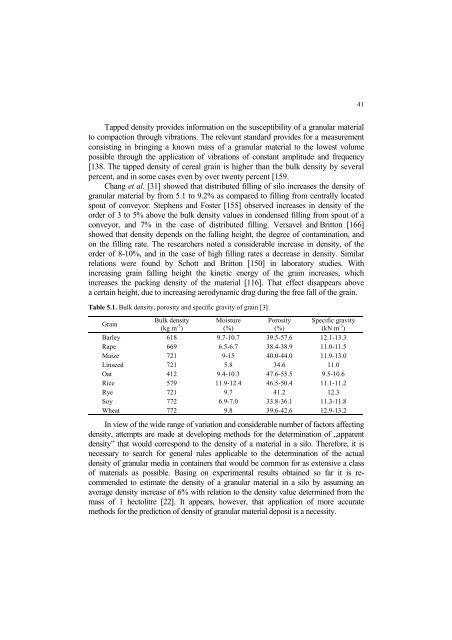Strona 2_redak - Instytut Agrofizyki im. Bohdana DobrzaÅskiego ...
Strona 2_redak - Instytut Agrofizyki im. Bohdana DobrzaÅskiego ...
Strona 2_redak - Instytut Agrofizyki im. Bohdana DobrzaÅskiego ...
Create successful ePaper yourself
Turn your PDF publications into a flip-book with our unique Google optimized e-Paper software.
41<br />
Tapped density provides information on the susceptibility of a granular material<br />
to compaction through vibrations. The relevant standard provides for a measurement<br />
consisting in bringing a known mass of a granular material to the lowest volume<br />
possible through the application of vibrations of constant amplitude and frequency<br />
[138. The tapped density of cereal grain is higher than the bulk density by several<br />
percent, and in some cases even by over twenty percent [159.<br />
Chang et al. [31] showed that distributed filling of silo increases the density of<br />
granular material by from 5.1 to 9.2% as compared to filling from centrally located<br />
spout of conveyor. Stephens and Foster [155] observed increases in density of the<br />
order of 3 to 5% above the bulk density values in condensed filling from spout of a<br />
conveyor, and 7% in the case of distributed filling. Versavel and Britton [166]<br />
showed that density depends on the falling height, the degree of contamination, and<br />
on the filling rate. The researchers noted a considerable increase in density, of the<br />
order of 8-10%, and in the case of high filling rates a decrease in density. S<strong>im</strong>ilar<br />
relations were found by Schott and Britton [150] in laboratory studies. With<br />
increasing grain falling height the kinetic energy of the grain increases, which<br />
increases the packing density of the material [116]. That effect disappears above<br />
a certain height, due to increasing aerodynamic drag during the free fall of the grain.<br />
Table 5.1. Bulk density, porosity and specific gravity of grain [3]<br />
Grain<br />
Barley<br />
Rape<br />
Maize<br />
Linseed<br />
Oat<br />
Rice<br />
Rye<br />
Soy<br />
Wheat<br />
Bulk density<br />
(kg m -3 )<br />
618<br />
669<br />
721<br />
721<br />
412<br />
579<br />
721<br />
772<br />
772<br />
Moisture<br />
(%)<br />
9.7-10.7<br />
6.5-6.7<br />
9-15<br />
5.8<br />
9.4-10.3<br />
11.9-12.4<br />
9.7<br />
6.9-7.0<br />
9.8<br />
Porosity<br />
(%)<br />
39.5-57.6<br />
38.4-38.9<br />
40.0-44.0<br />
34.6<br />
47.6-55.5<br />
46.5-50.4<br />
41.2<br />
33.8-36.1<br />
39.6-42.6<br />
Specific gravity<br />
(kN m -3 )<br />
12.1-13.3<br />
11.0-11.5<br />
11.9-13.0<br />
11.0<br />
9.5-10.6<br />
11.1-11.2<br />
12.3<br />
11.3-11.8<br />
12.9-13.2<br />
In view of the wide range of variation and considerable number of factors affecting<br />
density, attempts are made at developing methods for the determination of „apparent<br />
density” that would correspond to the density of a material in a silo. Therefore, it is<br />
necessary to search for general rules applicable to the determination of the actual<br />
density of granular media in containers that would be common for as extensive a class<br />
of materials as possible. Basing on exper<strong>im</strong>ental results obtained so far it is recommended<br />
to est<strong>im</strong>ate the density of a granular material in a silo by assuming an<br />
average density increase of 6% with relation to the density value determined from the<br />
mass of 1 hectolitre [22]. It appears, however, that application of more accurate<br />
methods for the prediction of density of granular material deposit is a necessity.
















